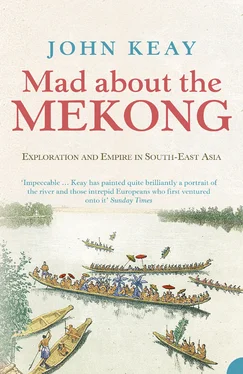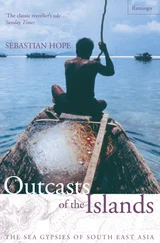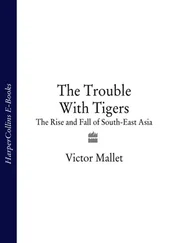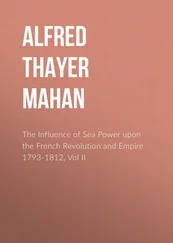This at least rang true. A wiry twenty-six, Francis Garnier was much the smallest of the party and quite young enough to be Lagrée’s son. At Naval School the young François (he later changed the spelling to ‘Francis’) was nicknamed ‘Mademoiselle Buonaparte’, an unflattering reflection on the contrast between his trim diminutive build and his loud extravagant ambitions. For grand vision as for outstanding stamina and courage, no one must be able to fault Francis Garnier. Single-minded, impulsive and intrepid, he was out both to prove himself and to prove that he was right. He had, in short (so to speak), all the attributes of the indomitable explorer, including an acute sense of his own self-importance. This ruled out anything recognisable as humour. Like the distant Lagrée, the driven Garnier would not be easy company. Happily the remaining four on the steps at Angkor would betray more appealing traits.
By way of the Arroyo de Poste the expedition reached the Tien Giang branch of the Mekong at the town of My-tho, then headed upstream. The river is said to have nine mouths, nine being a fair approximation to the geographical reality as well as an exceptionally auspicious number throughout Buddhist south-east Asia. In mythology and art the river is usually represented as a nine-headed serpent or dragon ( Cuu Long ). But the nine open-mouthed heads on their nine sinuous necks grow from just two scaly torsos, the Tien Giang or Upper River and the Hau Giang, Bassac, or Lower River. Each about a kilometre wide, the Tien Giang and the Hau Giang comprise the main navigational channels up through the Delta, braiding together the seven other effluents until they themselves converge to form the parent stream at Phnom Penh.
On either side of these twin conduits the Delta fans out to both the South China Sea and the Gulf of Siam (or Thailand). The map shows the Delta as eighty thousand square kilometres of very green land criss-crossed by a capillary of waterways. In reality, for at least half the year it is eighty thousand square kilometres of very glassy water criss-crossed by a web of causeways. The Mekong falls only six metres in its last eight hundred kilometres, but so low-lying is the Delta that the river in flood appears, and often is, the highest thing around. The land is so flat that from an upper deck you must allow for the curvature of the earth’s surface in counting the tiers of a distant pagoda; the lower ones may have ducked below the horizon. In fact the river feels as if it were itself cambered, with the boat driving along its crown, and lateral channels plunging to left and right or spilling under bridges to explore the orchards and inundate the cabbages.
After forcing its way for thousands of kilometres through mountain gorge and deepest forest, it is as if the river can scarcely believe its good fortune. Like a sluice released, it wells across the plain, exploring the arroyos , tugging at pontoons, basking in backwaters and generally making the most of its first and last unimpeded kilometres. Here nothing is quite what it seems. The man hoeing his field knee-deep in verdure turns out to be punting across it, his hoe a pole and his footing a boat. Behind him, along a tree-lined avenue, a rice barge churns into sight pushing a menacing bow wave. The Delta is said to produce more rice than any area of comparable size in the world. Beneath the glinting panes of water lie meadow and mud at no great depth. But rice-growing being a form of hydroponics, for the last six months of the year the fields are lakes and the landscape is a waterscape.
All that is not water in this aqueous world is ordained to wallow. Rusting car ferries shuttle across the main rivers with their decks awash. Upstream glides a mountain of pineapples propelled by a spluttering screw; downstream comes a haystack pirouetting on the current with a rudder and stern sticking out behind. Any craft boasting more draught than the thickness of a banana looks distinctly piratical, an impression heightened by the large painted eyes which adorn every prow and scan the flood ahead, lashless, boss-eyed and bloodshot, for any aquatic impertinence. By these eyes alone can one distinguish the houseboat from the house. Both are otherwise precarious constructions of water-blackened timbers festooned with clothing and potted geraniums.
Sampans, the river’s equivalent of bicycles, are the exception; they have no eyes because their bows, like the rest of the boat, lurk below the wash. Standing in midstream, the boatgirl plies her oars with the dexterous click of chopsticks, leaning into them and flicking through the stroke with the toss of a glossy ponytail. Porcelain forearms are encased in long-sleeved gloves, and trousered legs aflutter with the tails of a white ao dai (the long-skirted and daringly slit dress beloved of the Vietnamese). She dips in time with the stroke like a decorous metronome. This is how angels would row. Villages perched on nests of drunken stilts loom from the haze like preening storks. Children and ducks upend in the water; lawns of water hyacinth undulate along the bank.
Even the weather is of a mind to wallow. Above the eastern horizon billowing pillars of cloud mount to the stratosphere as the gathering gloom below is ignited with a son et lumière spectacle. Steel-grey and flecked with ochreous rust, another storm is lumbering up from the South China Sea. Hastily tarpaulins are hauled over open holds. A high-sterned country boat, junk-like but for the absence of a sail, guns its engine and heads for shelter. In the gathering gloom a string of tanker-barges carrying diesel for Cambodia is overhauled by the deluge.
Floods in the Mekong Delta rival cyclones in the Bay of Bengal as one of Asia’s meteorological clichés. Seldom does the rainy season (June – October) pass without an inundation, and in towns like My-tho on the Tien Giang and Can-tho on the Hau Giang the provident householder owns a liferaft. Here sampans may be seen jostling with bicycles at the traffic lights. In adjacent homes families cuddle up on top of the furniture to watch TV across a room afloat with toys. Property and crops suffer; but the Delta is used to these things, and fewer lives are lost than in the flash floods which occasionally affect the hilly areas of Vietnam. Nor is the river wholly to blame. The storms and tides surging in from the sea bear an equal responsibility.
A curious feature of these monsoon inundations in the Delta is that, while exacerbated by incoming tides, they appear to occur only in the evening. In the morning there are no floods and no visible tide. Inescapably therefore, the Mekong Delta seems to receive only one tide a day; and two tides every twenty-four hours being the rule throughout the rest of our planet, this phenomenon looks to be unique.
Such a freak of nature should surely have engaged the attention of Francis Garnier as the Mekong Exploration Commission’s hydrologist. But in his haste to whisk the expedition up to Angkor as quickly as possible, Garnier wastes not a word on the matter. Nor, to be fair, do most other writers on the Delta. In fact this tidal oddity is so little remarked and so clearly unnatural that one might suppose it imagined.
Confirmation can be found, though, in the appendices to volume two of a little-read but delightful work by H. Warington Smyth entitled Five Years in Siam. During his five years in the employ of the Siamese (Thai) government as a minerals prospector Warington Smyth also noticed the occurrence of what he calls ‘diurnal tides’ (once-daily, as opposed to the universal ‘semidiurnal’, or once-half-daily, tides). Writing in the 1890s and with reference to Thailand’s Menam river (or Chao Phraya) below Bangkok, he too had been puzzled and felt the matter worth investigating. This he had done with thoroughness, making his own observations throughout his five years, looking up such tide records as existed, and consulting all manner of seafarers.
Читать дальше












